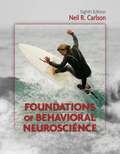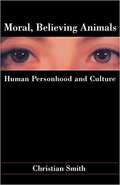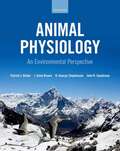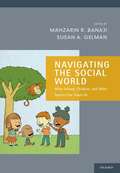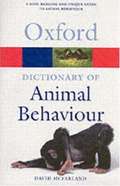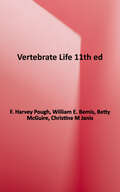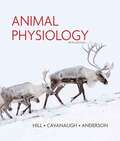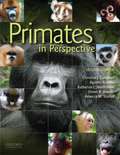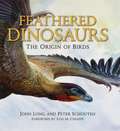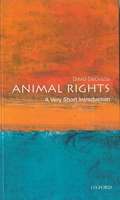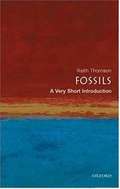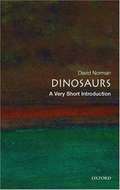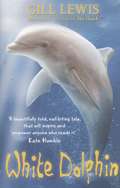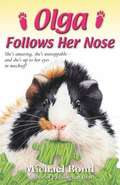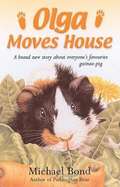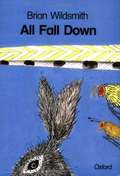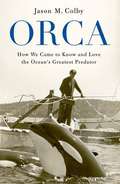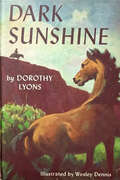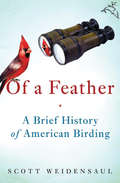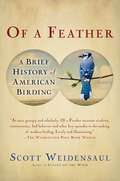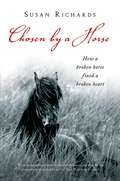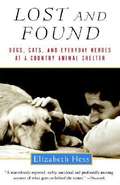- Table View
- List View
Peter Duck
by Arthur RansomeSeries: Swallows and Amazons series ; 03 In the third book of the adventures of the Walker and Blackett children, Peter Duck carries them onto the high seas. In their search for hidden treasure, under the command of the infamous Captain Flint (Uncle Jim), they brave fog, sharks, a real-life pirate, and ravenous crabs. Sequel to "Swallowdale." For grades 4-7 and older readers.
Foundations of Behavioral Neuroscience (Eighth Edition)
by Neil R. Carlson'Foundations of Behavioral Neuroscience' offers a briefer, sixteen chapter introduction to the foundations of physiology, incorporating the latest studies and research in the rapidly changing fields of neuroscience and physiological psychology.
Moral, Believing Animals: Human Personhood and Culture
by Christian SmithWhat kind of animals are human beings? And how do our visions of the human shape our theories of social action and institutions? InMoral, Believing Animals, Christian Smith advances a creative theory of human persons and culture that offers innovative, challenging answers to these and other fundamental questions in sociological, cultural, and religious theory. Smith suggests that human beings have a peculiar set of capacities and proclivities that distinguishes them significantly from other animals on this planet. Despite the vast differences in humanity between cultures and across history, no matter how differently people narrate their lives and histories, there remains an underlying structure of human personhood that helps to order human culture, history, and narration. Drawing on important recent insights in moral philosophy, epistemology, and narrative studies, Smith argues that humans are animals who have an inescapable moral and spiritual dimension. They cannot avoid a fundamental moral orientation in life and this, says Smith, has profound consequences for how sociology must study human beings.
Animal Physiology: An Environmental Perspective
by Patrick J. Butler J. Anne Brown D. George Stephenson and John R. SpeakmanWild animals survive in a variety of complex environments; they are exposed to predictable and unpredictable changes in their particular environment on a daily or seasonal basis. However, we live through times when almost all natural environments are undergoing relatively rapid change, and many of these changes, such as the pollution of air and water, removal of natural food sources, environment fragmentation, and climate change, are the result of human activity. Animal Physiology: An Environmental Perspective shows how an understanding of the physiology of animals in their natural habitats helps us to understand not only how and why animals evolved the way they did, but how we can act to protect at least some of them from the extreme effects of the changes affecting their environments. Part One sets the foundation for the topics covered in the remainder of the book by introducing a range of fundamental processes that are essential to life. It considers the diversity of habitats on Earth in which animals live, and examines animal groups and their evolutionary relationships. It then explores the different feeding strategies used by animals to obtain the energy they require to carry out all the essential functions of life, and how animals convert the chemical energy in food molecules into the energy they need to power all body functions. Finally, it explores the general properties of animal cells, and how animals maintain a suitable internal environment in which their cells are protected from external influences. We then examine those fundamental principles governing the main exchanges between the cells within animals, and between an animal and its environment. Parts two to four of the book explore how different organ systems - respiratory and circulatory systems, excretory organs and endocrine systems - enable animals to interact with their environment, and how environmental temperature profoundly affects the physiology of animals. Part five considers how the sensory and nervous systems provide animals with information on their internal as well as their external environment, and how they, together with the endocrine system, are involved in the control and co-ordination of muscles, reproduction, salt and water balance, and the cardio-respiratory systems.
Navigating the Social World: What Infants, Children, and Other Species Can Teach Us (Social Cognition and Social Neuroscience)
by Mahzarin R. Banaji Susan A. GelmanNavigating the social world requires sophisticated cognitive machinery that, although present quite early in crude forms, undergoes significant change across the lifespan. This book will be the first to report on evidence that has accumulated on an unprecedented scale, showing us what capacities for social cognition are present at birth and early in life, and how these capacities develop through learning in the first years of life. The volume will highlight what is known about the discoveries themselves but also what these discoveries imply about the nature of early social cognition and the methods that have allowed these discoveries -- what is known concerning the phylogeny and ontogeny of social cognition. To capture the full depth and breadth of the exciting work that is blossoming on this topic in a manner that is accessible and engaging, the editors invited 70 leading researchers to develop a short report of their work that would be written for a broad audience. The purpose of this format was for each piece to focus on a single core message: are babies aware of what is right and wrong, why do children have the same implicit intergroup preferences that adults do, what does language do to the building of category knowledge, and so on. The unique format and accessible writing style will be appealing to graduate students and researchers in cognitive psychology, developmental psychology, and social psychology.
A Dictionary of Animal Behaviour
by David McfarlandThis dictionary covers every aspect of animal behaviour, from aggression to courtship, animal welfare to cognition. It is essential reference for students of the biological sciences and psychology, professionals, and the general reader with an interest in natural history and zoology. Features: a unique reference guide to the subject; multi-disciplinary - covers terms from the related fields of ecology, physiology and psychology; entries backed up by specific examples of behaviour in the animal kingdom; and includes an index of common and Latin animal names.
Vertebrate Life, Eleventh Edition
by Betty McGuire F. Harvey Pough William E. Bemis Christine M JanisWidely praised for its comprehensive coverage and exceptionally clear writing style, this best-selling text explores how animals' anatomy, physiology, ecology, and behavior interact to produce organisms that function effectively in their environments and how lineages of organisms change through evolutionary time.
Animal Physiology (Sinauer Ser.)
by Richard HillComprehensive, contemporary, and engaging, Animal Physiology provides evolutionary and ecological context to help students make connections across all levels of physiological scale. One of the major challenges instructors and students face in Animal Physiology is making connections across levels of biological scale. Animal Physiology addresses this challenge by providing ecological and evolutionary context to the study of physiology at all levels of organization: genome, molecular biology, biochemistry, cells, tissues, organs, and organ systems. Hill's inclusion of ecology and evolution helps readers gain a holistic perspective on animal function and sets Animal Physiology apart from texts that focus more narrowly on physiology. Hill's Animal Physiology is trusted by instructors and students because of its authoritative, current, engaging, and lavishly illustrated presentation.
Primates in Perspective (2nd Edition)
by Agustin Fuentes Christina J. Campbell Katherine C. Mackinnon Rebecca M. Stumpf Simon K. BearderFeaturing forty-seven original essays by seventy leading researchers, Primates in Perspective, Second Edition, offers a comprehensive and contemporary overview of all major areas of primatology. Thoroughly revised and updated throughout, the second edition offers a diversity of theoretical positions on such topics as reproduction, ecology, and social behavior and intelligence. Primates in Perspective, Second Edition, is ideal for introductory primatology courses and can also be used in upper-division behavior and conservation courses. Additionally, it is an essential reference for primate researchers.
Feathered Dinosaurs: The Origin of Birds
by John A. Long Peter SchoutenScientists have recovered more than a billion fossils, but no discovery has been more breath-taking than the fossils recently found in northern China, findings which prove that several families of dinosaurs had feathers, or feathery hair-like coverings, adorning their bodies. Now in the beautifully designed Feathered Dinosaurs, paleontologist John Long and illustrator Peter Schouten provide a stunning visual record of these extraordinary prehistoric creatures, illuminating the evolutionary march from primitive, feathered dinosaurs through to the first true flying birds. Schouten, an acclaimed natural history artist, has created 80 full-color paintings that capture the striking physical traits of these feathered dinosaurs. Drawing on his extensive knowledge of the lifestyles of modern birds and mammals, plus the extant scientific data regarding how these dinosaurs might have looked and behaved, Schouten has produced not only the most beautiful but also the most accurate visual representations of these animals in print. Equally important, John Long, a noted paleontologist and widely published science author (with some 24 books to his credit), provides an engaging companion text that places these feathered dinosaurs within the larger family of dinosaurs--for instance, outlining their relationship to T. Rex and Velociraptor, species well known to Jurassic Park fans--and discusses the factual information that can be deduced from their fossil remains, in effect providing an insightful natural history of this remarkable group. A true marriage of art and science, Feathered Dinosaurs presents an unprecedented visual record of one of the most significant breakthroughs in the history of vertebrate paleontology--the discovery that many predatory dinosaurs were cloaked with feathers, perhaps just as colorful and fanciful as those of their living relatives.
Animal Rights: A Very Short Introduction
by David DegraziaThis volume provides a general overview of the basic ethical and philosophical issues of animal rights. It asks questions such as: Do animals have moral rights? If so, what does this mean? What sorts of mental lives do animals have, and how should we understand welfare? By presenting models for understanding animals' moral status and rights, and examining their mental lives and welfare, David DeGrazia explores the implications for how we should treat animals in connection with our diet, zoos, and research. Animal Rights distinguishes itself by combining intellectual rigor with accessibility, offering a distinct moral voice with a non-polemical tone.
Fossils: A Very Short Introduction
by Keith ThomsonFossils have not always been easily understood - there have been doubts about what they are and what they mean, and at times their very existence has threatened the prevailing views of the origins of life and the age of the Earth. Building on the latest scientific understanding, Keith Thomson places fossils in a very human context, highlighting their impact on mythology, philosophy, our concept of time, and popular culture. This Very Short Introduction provides a remarkably all encompassing explanation of fossils as a phenomenon.
Dinosaurs: A Very Short Introduction
by David NormanThe popularity of dinosaurs seems never ending, fueled by films such as Jurassic Park and documentaries (Walking with Dinosaurs). But how much do these popular programs really tell us about the recent scientific discoveries and the latest research into the world of the dinosaur? This is the first book to tell the general reader about what's really happening now in dinosaur research. It tells the story behind the exciting scientific discoveries that have built up a picture of how dinosaurs looked, what they ate, how they moved and interacted with each other. This new approach to this subject involves the combination of many areas of science (e.g. anatomy, cosmology, physics, mechanics and engineering design) to piece together the evidence of how animal/plant life evolved on earth, and why it did in the way that it did. David Norman also talks about the part that informed speculation and luck play in major discoveries. Starting with ancient myths of dinosaur-like monsters (dragons) and the history of the discovery of dinosaurs, he goes on to discuss the evolution of dinosaurs and the many different techniques used to understand them, including the latest virtual reality animation sequences and engineering design analysis.
White Dolphin
by Gill Lewis"The white dolphin is a sign that Mum's out there ..." When they first meet, Kara and Felix can't stand each other. But on discovering an injured dolphin calf on the beach they know they must work together to save it. Now friends, they set out to find the truth behind the disappearance of Kara's mother, and to protect the nearby reef. But powerful people don't want them to succeed. And with the odds stacked against them, how can Kara and Felix make their voices heard?
Olga Follows Her Nose (Olga da Polga #6)
by Michael BondLots of exciting things are happening at the Sawdust house and guinea pig Olga da Polga is right in the thick of it. First there's the strange jigsaw puzzle which looks good enough to eat, and then there's a mysterious visitor in the garden who thinks that Olga looks good enough to eat! And as if that weren't enough, Olga and her friends hear some shocking news that turns a perfectly ordinary day into 'Black Friday'. . . Each story has short chapters, each with their own plot, to build reading confidence.
Olga Moves House (Olga da Polga #5)
by Michael BondA brand new book about the mischievous guinea-pig, Olga da Polga. Winter has come to the Sawdust household, and Olga's been moved into a new home, inside the house. She's very excited about this and even manages to get Mrs Sawdust to redecorate her box! Olga enjoys watching the comings and goings in the house and gets up to all kinds of mischief and embarks on many wonderful adventures. * A brand new Olga da Polga book, by the best-selling author of 'Paddington Bear' books.
All Fall Down
by Brian WildsmithThe bee is on the butterfly. The butterfly is on the bird. The bird is on the seal. But the seal is on a ball...
The Right-Hand Man
by K. M. PeytonNed Rowlands--twenty, red-haired and impudent--is the fastest stagecoach driver on the Harwich road. His reckless driving--as full of dash as he is--attracts the attention of young Lord Ironminster who had been, before an accident which cost him an arm, the best dragsman in England. Ironminster is determined to win a racing wager against his cousins James and Rupert Saville and so greatly needs Ned's help. Ned enters a strange partnership which involves his emotions as well as his talents; for he soon realizes that far more is at stake than a mere wager: Ironminster is a sick man and must marry and produce an heir if his estate is not to pass to James Saville. As Ironminster's right-hand man, Ned is to play an important part in helping his master to outwit his cousins - a more dangerous role than that of the driver of a four-in-hand. Mrs Peyton has brought the world 1818-19 vividly to life. In describing the elegance and glamour of the Georgian period, she never loses sight of its brutality, its social injustices and its squalor. Her story is packed with action, colour and period detail and is as readable as the earlier books which won her her well- deserved reputation as 'an outstandingly interesting and original writer of novels for teenage readers.'
Animal Behavior: Concepts, Methods, and Applications, Third Edition
by Shawn E. Nordell Thomas J. ValoneEmphasizes Concepts. Animal Behavior: Concepts, Methods, and Applications, Third Edition, uses broad organizing concepts to provide a framework for understanding the science of animal behavior. In an engaging, question-driven style, Shawn E. Nordell and Thomas J. Valone offer readers a clear learning progression for understanding and evaluating empirical research examples. Focuses On Methodology and The Process of Science. Featured studies illustrate each concept and emphasize the experimental designs and the hypothesis testing methods scientists use to address research questions. Highlights Real-World Applications. Concepts are related to real life to help students understand the broader significance of animal behavior research, including applications to human behavior and conservation.
Orca: How We Came to Know and Love the Ocean's Greatest Predator
by Jason ColbySince the release of the documentary Blackfish in 2013, millions around the world have focused on the plight of the orca, the most profitable and controversial display animal in history. Yet, until now, no historical account has explained how we came to care about killer whales in the first place. <p><p> Drawing on interviews, official records, private archives, and his own family history, Jason M. Colby tells the exhilarating and often heartbreaking story of how people came to love the ocean's greatest predator. Historically reviled as dangerous pests, killer whales were dying by the hundreds, even thousands, by the 1950s--the victims of whalers, fishermen, and even the US military. In the Pacific Northwest, fishermen shot them, scientists harpooned them, and the Canadian government mounted a machine gun to eliminate them. But that all changed in 1965, when Seattle entrepreneur Ted Griffin became the first person to swim and perform with a captive killer whale. The show proved wildly popular, and he began capturing and selling others, including Sea World's first Shamu. <p> Over the following decade, live display transformed views of Orcinus orca. The public embraced killer whales as charismatic and friendly, while scientists enjoyed their first access to live orcas. In the Pacific Northwest, these captive encounters reshaped regional values and helped drive environmental activism, including Greenpeace's anti-whaling campaigns. Yet even as Northwesterners taught the world to love whales, they came to oppose their captivity and to fight for the freedom of a marine predator that had become a regional icon. <p> This is the definitive history of how the feared and despised "killer" became the beloved "orca"--and what that has meant for our relationship with the ocean and its creatures.
Dark Sunshine
by Dorothy LyonsTwo years before, horse-loving Blythe Hyland would have been thrilled with the news that the family was moving back to an Arizona ranch, but now--what difference did it make to her? What could a thin, listless girl, crippled by polio, do on a ranch? Then the haunting vision of Blind Man's Pocket, a deep spring-fed valley tucked away in a range of mountains, tempted her to try riding a horse again. And when she had conquered her initial panic, Blythe felt that it might be hers once more. It was in Blind Man's Pocket Blythe found Dark Sunshine, a magnificent wild mare that had been trapped by a landslide. From the moment she learned it was possible to rescue the buckskin, Blythe determined that, crutches or no, she would train and ride her. It was slow, often painful work for the crippled girl, but when an endurance ride offered Blythe her only chance to win athletic honors toward a scholarship, both horse and rider were ready for the grueling test. Dorothy Lyons' earlier books have established her as a favorite writer of horse stories for older girls. In this moving story of a girl whose courage overcame the handicap of a useless leg, she has created an inspiring book that young readers will remember.
Of a Feather: A Brief History of American Birding
by Scott WeidensaulBeyond Audubon: A quirky, &“lively and illuminating&” account of bird-watching&’s history, including &“rivalries, controversies, [and] bad behavior&” (The Washington Post Book World). From the moment Europeans arrived in North America, they were awestruck by a continent awash with birds—great flocks of wild pigeons, prairies teeming with grouse, woodlands alive with brilliantly colored songbirds. Of a Feather traces the colorful origins of American birding: the frontier ornithologists who collected eggs between border skirmishes; the society matrons who organized the first effective conservation movement; and the luminaries with checkered pasts, such as Alexander Wilson (a convicted blackmailer) and the endlessly self-mythologizing John James Audubon. Naturalist Scott Weidensaul also recounts the explosive growth of modern birding that began when an awkward schoolteacher named Roger Tory Peterson published A Field Guide to the Birds in 1934. Today, birding counts iPod-wearing teens and obsessive &“listers&” among its tens of millions of participants, making what was once an eccentric hobby into something so completely mainstream it&’s now (almost) cool. This compulsively readable popular history will surely find a roost on every birder&’s shelf. &“Weidensaul is a charming guide. . . . You don&’t have to be a birder to enjoy this look at one of today&’s fastest-growing (and increasingly competitive) hobbies.&” —The Arizona Republic
Of a Feather: A Brief History of American Birding
by Scott WeidensaulEuropeans were awestruck by a continent awash with birds. Today tens of millions of Americans birders have made a once eccentric hobby into something so mainstream its (almost) cool. Scott Weidensaul traces the colorful evolution of American birding.
Chosen by a Horse: A Memoir
by Susan RichardsThe horse that the author chose for rescue wouldn't be corralled into her waiting trailer. But Lay Me Down, a former racehorse with a foal close on her heels, walked right up the ramp and into Susan's life. Weak from malnutrition, Lay Me Down had endured a rough road, but somehow her heart was still open and generous. Fate brought her into Susan's paddock, where she taught Susan about life and love.
Lost and Found: Dogs, Cats, and Everyday Heroes at a Country Animal Shelter
by Elizabeth HessIn Lost and Found, Hess brings you behind the scenes in this thorough examination of the day-to-day workings of the shelter.

